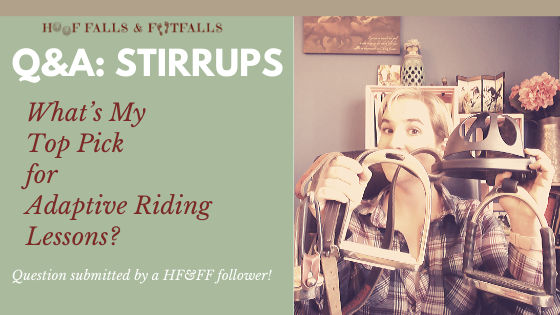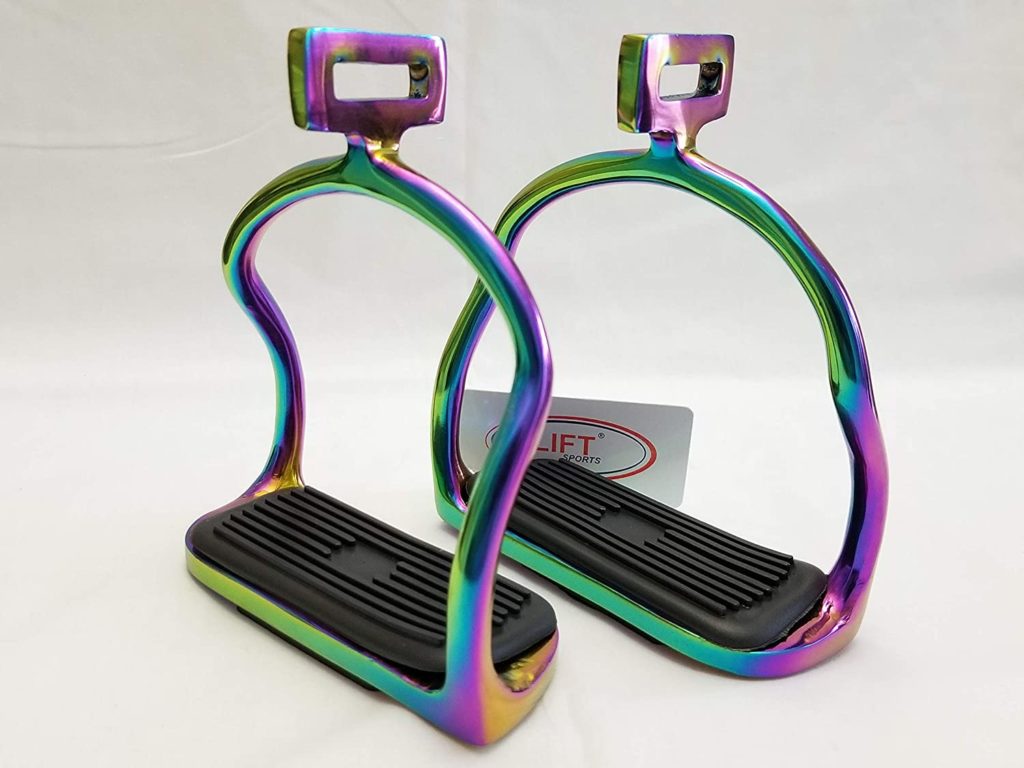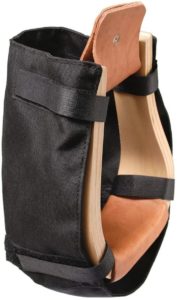Question:
“There are several different types of stirrups out there. Which one do you like to use for your adaptive/therapeutic riding lessons?”
Answer:
It depends!
I have several different types of stirrups and each one of them have pros and cons which I will list below.
But…before we get into the types of stirrups and when/why I may use a certain type here is a quick note on stirrups: Since I am a certified professional through PATH Intl., I follow the guidelines in the PATH Intl. Standards for Certification and Accreditation manual (available free online through PATH Intl. for current members). The 2018 version of the manual has a policy regarding stirrups as follows:
“Is there an implemented written policy regarding the use of stirrups with safety features, AND/ OR is there an implemented written policy that participants wear riding boots or hard-soled shoes with heels?”
Interpretation: Stirrups should have safety features that reduce the chance of foot entrapment and should be in good working order. The student’s individual needs should be considered when selecting the type of safety stirrup. The written policy may address use of safety stirrups, use of boots by participants or both.
–Professional Association of Therapeutic Horsemanship International Standards for Certification & Accreditation 2018 Edition
My Stirrup Policy
The policy below is for both traditional and adaptive** horseback riding lessons.
“Participants will wear riding boots or hard soled boots with heels if riding in traditional, non-safety stirrups. Participants that wear closed toed shoes that are not considered appropriate riding boots and/or are not hard soled shoes with heels must ride in stirrups with safety features (i.e.: “safety stirrups”).”
Even though my current written policy says students can ride in traditional non-safety stirrups if they have appropriate footwear, I usually opt for safety stirrups over traditional non-safety stirrups. I talk more about this under the flexi iron section
Safety Considerations for Peacock Stirrup Use
Click this link to view a blog and video that discusses in detail safety considerations and appropriate use when using peacock stirrups. Tips and tricks are also given to prevent rider hangups when dismounting.
Peacock Stirrups
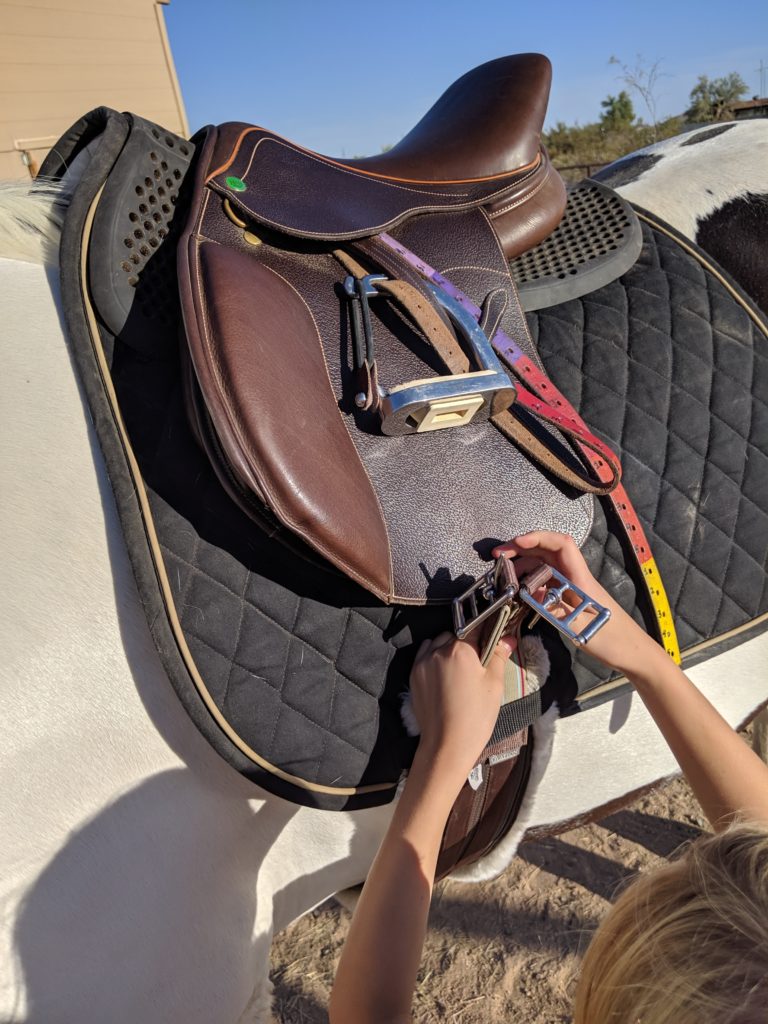
The peacock stirrup, at least in my region, is one of the more common “safety stirrups” used in traditional and adaptive riding lessons.
For most traditional and adaptive students under 12ish years of age, these are usually my first choice.
In order to be considered a “safety” stirrup they must be used correctly which means that when the rider’s foot is in the stirrup the rubber band is facing to the outside. It is also a good idea to have the stirrup bar of the saddle in the “down” position so there is a second release point for the stirrup/stirrup leather in an emergency. Click HERE to read a blog and see a video on this topic.
Click HERE for kids size stirrups or HERE for adult sizes. They also have fun rainbow metallic peacock stirrups available HERE…where were these when I was a kid?
Pros:
- They come in many different sizes (from tiny kids to adult)
- They are easy to find in tack stores and online.
- They are usually of a good medium weight
Cons:
- Students and volunteers can get hung up on the hook side of the stirrup. The stirrups can also get hung up on certain types of fencing, props in the arena, etc.
- Read this BLOG post with a quick tip on preventing rider hang-ups during dismounting.
- The safety bands need replaced often. Need to get a replacement for your set? Click HERE.
- The stirrups can become bent over time which can cause a rider’s foot to slip out towards the rubber band side. This often happens with the adult sized ones due to the size of the stirrup and the size of the rider using them.
- They are not “safety” stirrups if they are not used correctly.
- If they are too small for a rider, a foot can become wedged in between the edges of the stirrup platform.
S and SS Stirrups
S Stirrups seem to have become more common over the past few years (again…I think it may be a regional thing).
These are usually my first choice for teen and adult riders since these have the most
S stirrups– In order to be considered a “safety” stirrup they must be used correctly which means that when the rider’s foot is in the stirrup the S of the stirrup to the outside and it “bubbles” out towards the horse’s head. Like the peacock stirrup, it is also a good idea to have the stirrup bar of the saddle in the “down” position so there is a second release point for the stirrup/stirrup leather in an emergency.
Get the light weight S Stirrups HERE.
SS Stirrups– I just learned about these recently from a fellow instructor! The cool thing about this type of stirrup is that as long as they are put on correctly, the safety feature will work even if a rider gets their stirrup/stirrup leather twisted! I do not personally own a pair yet but will be adding them to my collection soon.
Get the light weight SS Stirrups HERE or fun metallic rainbow SS Stirrups HERE!
Pros:
- Unlike the peacock, the S and SS stirrups don’t have anything for the rider or volunteers to get hung up on.
- They hold their shape well even after years of use.
- The weight of the stirrup is evenly distributed around the foot (since there is metal all the way around, unlike the peacock stirrup that has one lighter side where the band is at).
- They come in large sizes which are great for adults.
Cons:
- Depending on the material they are made from they can be a bit on the heavy side. Some riders like the heavier weight while some do not because it can fatigue joints and muscles.
- They are not “safety” stirrups if they are not used correctly (S) and/or installed correctly (SS).
- If they are too big or too small for a rider they can cause a foot to become stuck (too small for rider) or allow a foot to slip all the way through (too big for the rider).
Cage Stirrups
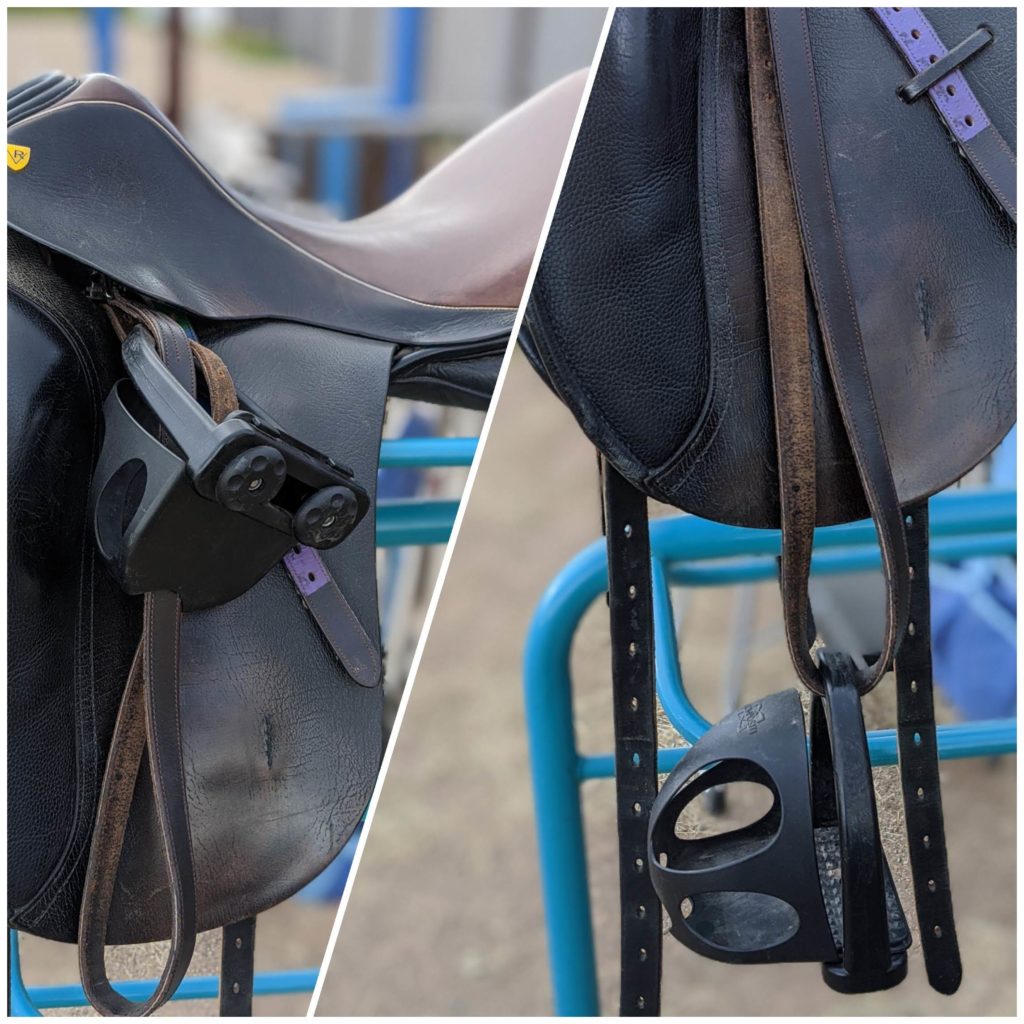
Out of all the stirrups listed in this article, the cage stirrups are the ones I have used the shortest amount of time.
Cage stirrups are my go to for students who have difficulty comprehending how to keep their foot safely placed in a stirrup, ones that like to push their foot deep into a stirrup, and/or or students that need a little more stability but do not need a heel hold from sidewalkers.
You can get aluminum cage stirrups HERE or plastic ones HERE.
Pros:
- They can prevent riders from pushing their foot all the way through the stirrup.
- They are often very lightweight.
- They have a bigger platform/area for the foot to set on which sometimes helps riders feel more secure.
- They come in fun colors.
Cons:
- They can be too light. While some riders may like and benefit from a very light stirrup, most students like some weight to their stirrups.
- Some riders unconsciously push their foot all the way into the cage which can create a toe down foot position.
- Some riders feel the need to push down more onto the bigger platform/area where their foot is setting. This can create a toe down position and/or they push their leg forward.
- They can be bulky for sidewalkers to walk next to, especially those doing a thigh hold or working closely providing hand over hand support.
- They can be bulky and get in the way of dismounts if not moved out of the way.
Flexi Irons
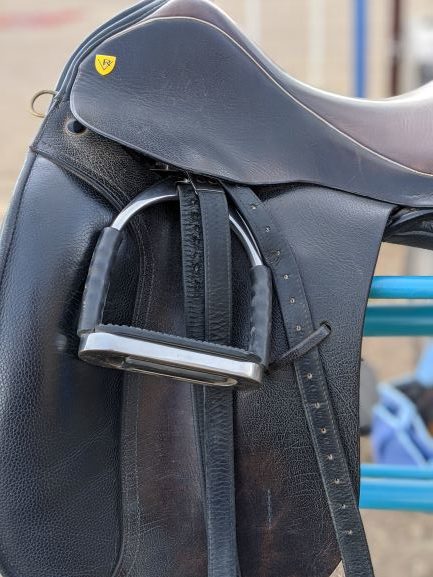
Flexi Irons
These are my stirrups of choice for personal riding and for more advanced students who 1) have appropriate riding boots and 2) also know how/when to safely remove their feet from the irons in an emergency situation. I also commonly leave the stirrup barn in the “down” position when a student rides in these.
I have hip and lumbar area issues which can cause cramps and joint discomfort if I ride for an extended time or do more intense activities. These stirrups have really helped make longer and more intense rides more comfortable.
Click HERE to see a brand similar to the ones I personally use.
Pros:
- Comfortable
- Hold up well
- Good weight (at least I personally like the weight of them)
Cons:
- Most are NOT safety stirrups (even though they often come up when you search “safety stirrup” on amazon or google).
- Can be an investment depending on the brand and type you get.
Other Stirrup Options
Below are a few other stirrup options I have used in the past for both traditional and adaptive riding lessons. I do not currently own these but I have heard other instructors in the Equine Assisted Activities and Therapies (EAAT) industry also recommend these options.
Stirrup covers
- If put on correctly, these can turn traditional English or western stirrups into “safety stirrups”. They must be put on in a way that fully covers the front of the stirrup so the foot cannot slip through and get stuck.
- Click HERE to view item
Western/Endurance Cage Stirrups
- I have heard instructors and riders say that these really help with joint comfort and ankle stability.
- Click HERE to view item
Western Easy Out Youth Stirrup
- These are like an English peacock stirrup. Make sure the easy release side is facing out when the foot is in the stirrup.
- Click HERE to view item
What are your go-to stirrups? I’d love to hear in the comment section!

** I personally chose to use the term Adaptive Riding vs. Therapeutic Riding and avoid ‘horse therapy’ at all costs. Why? CLICK HERE. The thoughts shared in the post above apply to not only Adaptive riding but also to other mounted equine activities and therapies offered at an EAAT (Equine Assisted Activity and Therapy) Program/Center/Barn.
This page contains Amazon Affiliate Links. I earn a small commission off any products purchased through my affiliate links. This commission goes right back into HF&FF to help offset the time, money, and resources it takes to creating free and low-cost EAAT Instructor education! Thank you for your purchases though my links!

